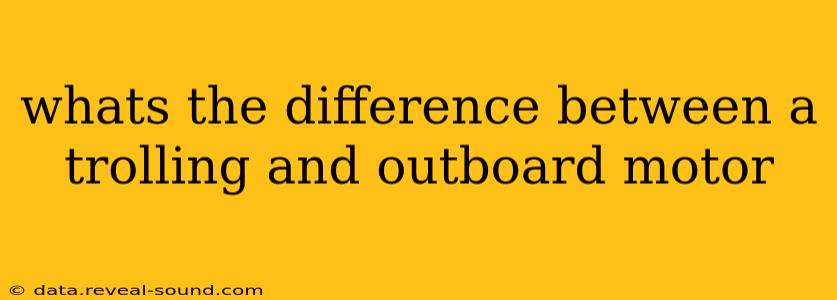What's the Difference Between a Trolling Motor and an Outboard Motor?
Choosing the right motor for your boat depends heavily on your needs and the type of boating you plan to do. Understanding the key differences between trolling motors and outboard motors is crucial for making the right decision. These two types of motors serve very different purposes, despite both propelling a boat through water.
Outboard Motors: Power and Speed
Outboard motors are powerful engines designed for speed and maneuverability across larger bodies of water. They are typically gasoline-powered (although electric outboards are gaining popularity) and mounted on the outside of the boat's transom (the back).
- Power: Outboards deliver significant horsepower, ranging from a few horsepower for small inflatables to hundreds of horsepower for large fishing boats and speedboats. This allows for high speeds and the ability to handle rough waters.
- Speed: Their primary function is to propel the boat quickly across the water.
- Maneuverability: While they offer good maneuverability, especially with power steering, they're not ideal for precise, slow-speed control.
- Fuel: Generally run on gasoline, requiring regular fuel stops. Electric outboards are a cleaner, quieter, and increasingly powerful alternative.
- Size and Weight: Outboards are relatively large and heavy, requiring substantial mounting and potentially adding significant weight to the boat’s stern.
Trolling Motors: Precision and Quiet Operation
Trolling motors are smaller, lower-powered motors primarily designed for slow, quiet movement, usually for fishing. They are often electric, though some gas-powered trolling motors exist. These motors are typically mounted on the bow (front) of the boat.
- Power: They offer significantly less horsepower than outboards, usually ranging from 30-80lbs of thrust. The thrust rating is a better indicator of power than horsepower for trolling motors.
- Speed: They are not meant for high speeds; their purpose is slow, controlled movement.
- Maneuverability: Excellent for precise control and slow maneuvering, particularly important when fishing. They frequently have features like variable speed control and foot pedals for precise positioning.
- Fuel: Most are electric, operating on batteries, offering quiet operation and reduced environmental impact. This eliminates the noise and fumes associated with gas-powered motors.
- Size and Weight: Trolling motors are considerably smaller and lighter than outboards.
Here's a table summarizing the key differences:
| Feature | Outboard Motor | Trolling Motor |
|---|---|---|
| Primary Use | High-speed travel, general boating | Slow, quiet fishing, precise control |
| Power Source | Primarily gasoline, some electric | Primarily electric, some gas |
| Power Output | High horsepower | Lower thrust (lbs) |
| Speed | High | Low |
| Noise Level | High | Low |
| Maneuverability | Good | Excellent |
| Mounting | Transom | Bow |
What is a trolling motor used for?
Trolling motors are primarily used for fishing. Their quiet operation allows anglers to approach fish without spooking them. The precise control they offer allows for accurate positioning of the boat over fishing spots. They are also useful for navigating shallow waters and tight spaces where a larger outboard might be impractical or damaging.
What is the best type of trolling motor?
The "best" trolling motor depends on your needs and boat size. Consider factors like thrust (the pushing power), shaft length (to match your boat's hull depth), and battery type (deep-cycle marine batteries are essential). Brands like Minn Kota and MotorGuide are popular choices, offering a variety of models with different features.
What are the benefits of an electric trolling motor?
Electric trolling motors are virtually silent, environmentally friendly, and easy to maintain. They require less maintenance than gas-powered motors and eliminate the need for storing and handling gasoline. Their quiet operation is a major advantage for fishing.
Can I use a trolling motor as my primary motor?
While some smaller boats might exclusively use a powerful trolling motor, it's generally not recommended. Trolling motors lack the horsepower for efficient travel at higher speeds or in challenging conditions. They are best used as a supplemental motor to an outboard for increased control and quiet operation when needed.
By understanding these core differences, you can confidently select the appropriate motor type for your boating activities, ensuring a safe and enjoyable experience on the water.
